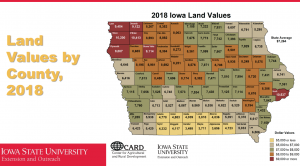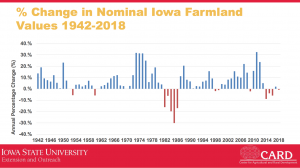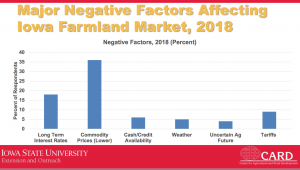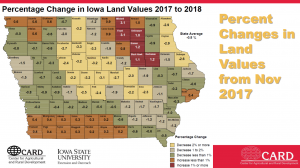Agriculture leaders in the United States House of Representatives are looking to provide at least an additional $10 billion in farmer aid to supplement the recently announced Farmer Bridge Assistance…
Iowa Farmland Values Decrease Slightly Since 2017
A news release Wednesday from the Center for Agricultural and Rural Development at Iowa State University and Iowa State University Extension and Outreach indicated that, “After a reprieve in 2017, commodity prices, interest rates, and trade disruptions drove Iowa farmland values down for the fourth time in five years. The average statewide value of an acre of farmland is now estimated to be $7,264. This represents a decrease of 0.8 percent, or $62 per acre, from the 2017 estimate.”

“Farmland values hit an historic peak of $8,716 per acre in 2013; however, they immediately declined by 8.9 percent, 3.9 percent, and 5.9 percent, respectively, the following three years. Farmland owners received a small reprieve in 2017 when the statewide average increased 2.0 percent,” the release said.

The news release also noted that, “While modest when compared to 2014, 2015, and 2016, 2018 marks the fourth time in five years that statewide average farmland values have declined. In nominal value, the statewide average for an acre of farmland has fallen 17 percent since 2013.”

Wednesday’s update quoted Dr. Wendong Zhang, an Assistant Professor of Economics at Iowa State University, who led the annual survey, as saying, “Lower commodity prices, in part due to the recent trade disruptions, were cited as the most significant negative factor driving down land values.”

In a more detailed overview of the Survey, Dr. Zhang pointed out that, “Seventy of 99 counties in Iowa reported a drop in land value, while the remaining 29 counties saw an increase.”

The analysis of the results also pointed out that, “The 2018 ISU Land Value Survey shows that the majority of farmland sales, 72 percent, were to existing farmers. Investors represented 21 percent of land sales. Estate sales were still the main source of sales, followed by sales by retired farmers.”





